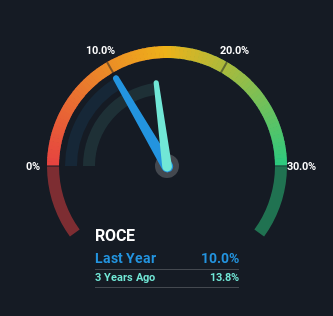Returns On Capital Signal Tricky Times Ahead For StarHub (SGX:CC3)
To find a multi-bagger stock, what are the underlying trends we should look for in a business? Typically, we'll want to notice a trend of growing return on capital employed (ROCE) and alongside that, an expanding base of capital employed. This shows us that it's a compounding machine, able to continually reinvest its earnings back into the business and generate higher returns. In light of that, when we looked at StarHub (SGX:CC3) and its ROCE trend, we weren't exactly thrilled.
Return On Capital Employed (ROCE): What Is It?
If you haven't worked with ROCE before, it measures the 'return' (pre-tax profit) a company generates from capital employed in its business. Analysts use this formula to calculate it for StarHub:
Return on Capital Employed = Earnings Before Interest and Tax (EBIT) ÷ (Total Assets - Current Liabilities)
0.10 = S$197m ÷ (S$3.0b - S$994m) (Based on the trailing twelve months to June 2023).
So, StarHub has an ROCE of 10.0%. On its own that's a low return on capital but it's in line with the industry's average returns of 10%.
Check out our latest analysis for StarHub
In the above chart we have measured StarHub's prior ROCE against its prior performance, but the future is arguably more important. If you'd like, you can check out the forecasts from the analysts covering StarHub here for free.
So How Is StarHub's ROCE Trending?
On the surface, the trend of ROCE at StarHub doesn't inspire confidence. Over the last five years, returns on capital have decreased to 10.0% from 20% five years ago. Although, given both revenue and the amount of assets employed in the business have increased, it could suggest the company is investing in growth, and the extra capital has led to a short-term reduction in ROCE. If these investments prove successful, this can bode very well for long term stock performance.
The Bottom Line
Even though returns on capital have fallen in the short term, we find it promising that revenue and capital employed have both increased for StarHub. And there could be an opportunity here if other metrics look good too, because the stock has declined 25% in the last five years. So we think it'd be worthwhile to look further into this stock given the trends look encouraging.
If you want to continue researching StarHub, you might be interested to know about the 4 warning signs that our analysis has discovered.
While StarHub may not currently earn the highest returns, we've compiled a list of companies that currently earn more than 25% return on equity. Check out this free list here.
Have feedback on this article? Concerned about the content? Get in touch with us directly. Alternatively, email editorial-team (at) simplywallst.com.
This article by Simply Wall St is general in nature. We provide commentary based on historical data and analyst forecasts only using an unbiased methodology and our articles are not intended to be financial advice. It does not constitute a recommendation to buy or sell any stock, and does not take account of your objectives, or your financial situation. We aim to bring you long-term focused analysis driven by fundamental data. Note that our analysis may not factor in the latest price-sensitive company announcements or qualitative material. Simply Wall St has no position in any stocks mentioned.

